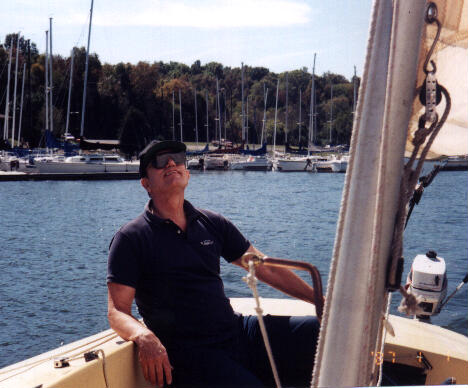
Haught with "new" boat - an old, cheap, wonderful, 19-foot Flying Scot
(Photo by ex-skipper John Callighan)

Haught with "new" boat - an old, cheap, wonderful, 19-foot Flying
Scot
(Photo by ex-skipper John Callighan)
But when I'm out on a lake in my beloved old 14-footer, skimming silently on the free power of nature, I'm Lief Ericson, I'm Christopher Columbus, I'm the Polynesian explorers, I'm the Nile boatmen in their feluccas, I'm Chesapeake Bay oystermen in their Skipjacks, I'm Albert Einstein on Saranac Lake, I'm Jack Kennedy off Hyannis Port, I'm Ted Turner winning the America's Cup -- I'm everyone who ever felt the joy of flying with the wind over sparkling water.
Real sailors -- oceangoing sailors -- probably smile indulgently at us boondocks boaters, who ply our dinghies on skinny lakes and rivers between the mountains of Appalachia. But that doesn't matter. We're hooked, regardless.
In my state of West Virginia, 50,000 pleasure boats are licensed -- but fewer than 1,000 of them are sailboats. Most sailors have craft like my Force Five, which lack motors and don't need licenses.
One reason that Appalachia has few sailors is because mountain country is the worst for sailing -- no wide bays, no constant winds, no traditional yacht clubs or regattas. Still, we make do with what's available.
West Virginia has 93 public lakes, about half of them large enough for sailing. Biggest is Summersville Lake, at 2,700 acres. Close behind is the new Stonewall Jackson Lake near Weston, with 2,650. It features the newest state park, with 374 boat slips -- testimony to the growth of boating.
Other major West Virginia lakes: Bluestone in Summers County (2,040 acres); Tygart, Taylor County (1,750); Cheat, Monongalia County (1,730); Sutton, Braxton County (1,500); Mount Storm, Grant County (1,200); East Lynn, Wayne County (1,005); Burnsville, Braxton County (968); Jennings Randolph, Mineral County (952); and Beech Fork, near Huntington (720).
The 10 largest are operated by the U.S. Army Corps of Engineers, which reports 6 million visitors a year, counting all picnickers, anglers, swimmers and campers.
The state also has hundreds of miles of navigable
rivers, dotted with marinas.
The river rat in The Wind in the Willows said "There is nothing --
absolutely nothing -- half so much worth doing as simply messing about in
boats.'' Plenty of messing about happens in Appalachia.
On many of these waters, we sailors ply the no-wake zones or out-of-the-way inlets, to avoid the choppy wakes churned up by power craft. At a few places, the roaring jet-set is no problem, because big motors are banned.
My favorite getaway spot is Beech Fork Lake, a lovely retreat 10 miles south of Huntington. It's a jewel of a nature haven, frequented by deer, geese and huge cranes that look like hang-gliders. The Corps of Engineers forbids outboard motors larger than 10 horsepower, so there are only fishermen's john-boats and a flotilla of meandering pontoon craft. The entire lake is a sailboat playground.
Gliding lazily on an Appalachian lake, I'm often struck by the perfection of gravity. Hills rise and fall all around, but the water surface strikes an absolute level through the jumble.
Sailors know a special thrill of being close to nature, competing with the elements. We trick the wind and water into yielding a noiseless, graceful, free ride that seems much faster than it is. A sailboat "comes alive'' in a breeze and requires skillful handling to attain speed and control -- always with the risk that a flub will dunk the craft and the boaters. (I once capsized nose-first at Beech Fork, like a submarine in a crash dive.) The stronger the wind, the more the crew hangs over the side, riding the edge of excitement like occupants of a roller-coaster.
Amazing physics is involved. The curved sail, tight in the wind, becomes an airfoil like an airplane wing. Air traveling over the outside of the curve goes farther, hence faster, and has lower pressure (according to the Bernoulli Principle, which says fast-moving gases have less pressure). Higher pressure behind the sail shoves forward -- and the dagger-board or keel below prevents sidewise slippage. That's why a boat can sail partly toward the wind.
But sailors don't need to know physics. All they need to understand is a few operating rules, and they're off. I got hooked in middle age. My wife saw an 11-foot boat in a yard sale for $450, and thought it might be fun for our four children to use at the small private lake where we live. The kids were bored -- they prefer slam-bang sports -- but I tried it and was enchanted.
Later I sold the 11-footer and bought a used Force Five (named for a category in the rating system for storm winds) for $500. Small-boat sailing is economical. Sailors tend to spend a pittance, then feel superior to power boaters in their $20,000 craft.
The Force Five has a planing hull that skims the top of waves as speed increases. When sunlight is glistening on the ripples, and the planing boat is sending out a spray that glints in the sun, you ride a million sparkles. I hope to ride those sparkles as long as I live.
Sailing is a sort of poetry. In the Book of Proverbs, Solomon ranked it among these marvels:
"There be three things which are too wonderful for me, yea, four which I know not: The way of an eagle in the air; the way of a serpent upon a rock; the way of a ship in the midst of the sea; and the way of a man with a maid.''
